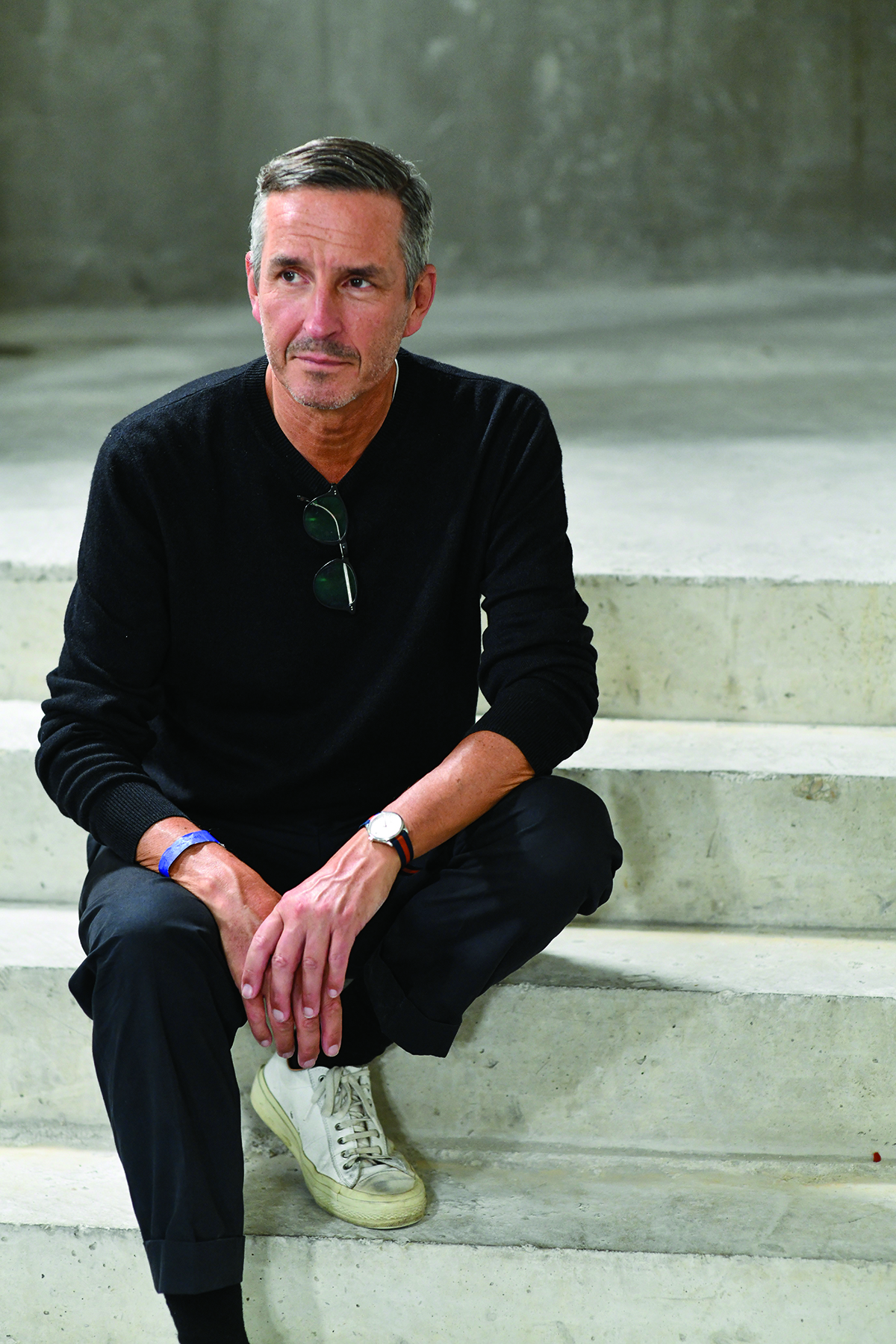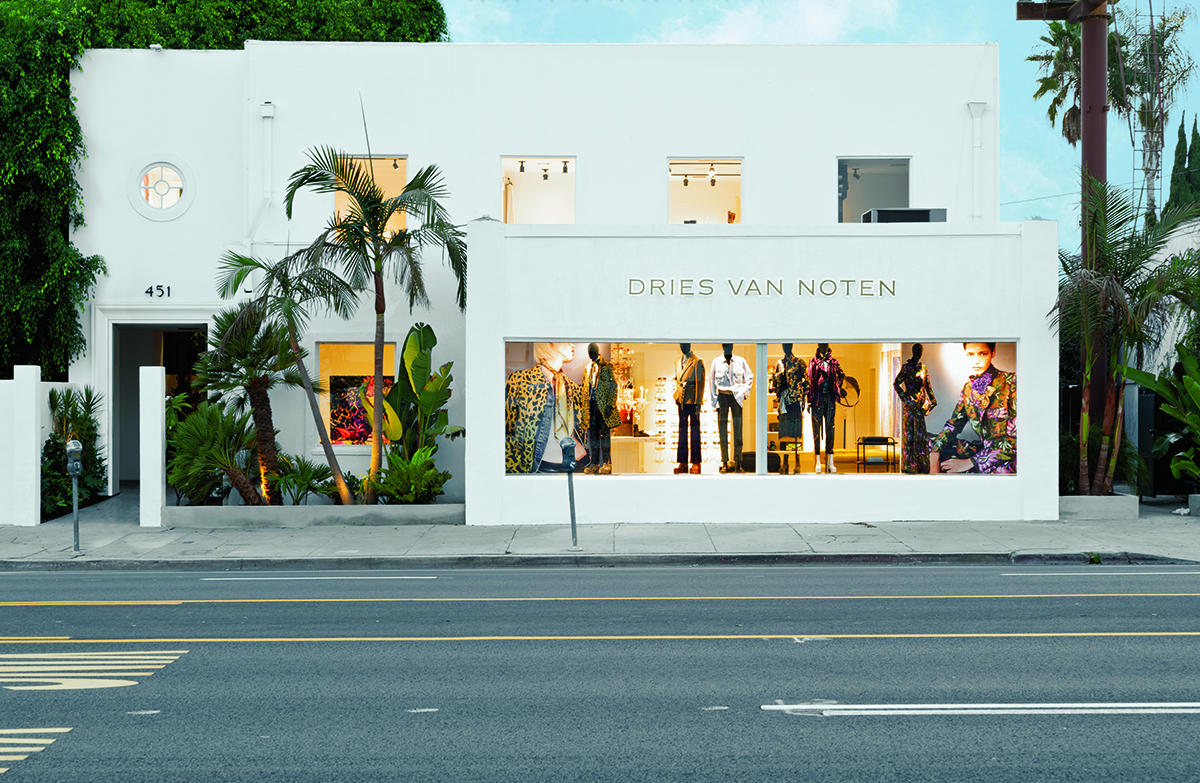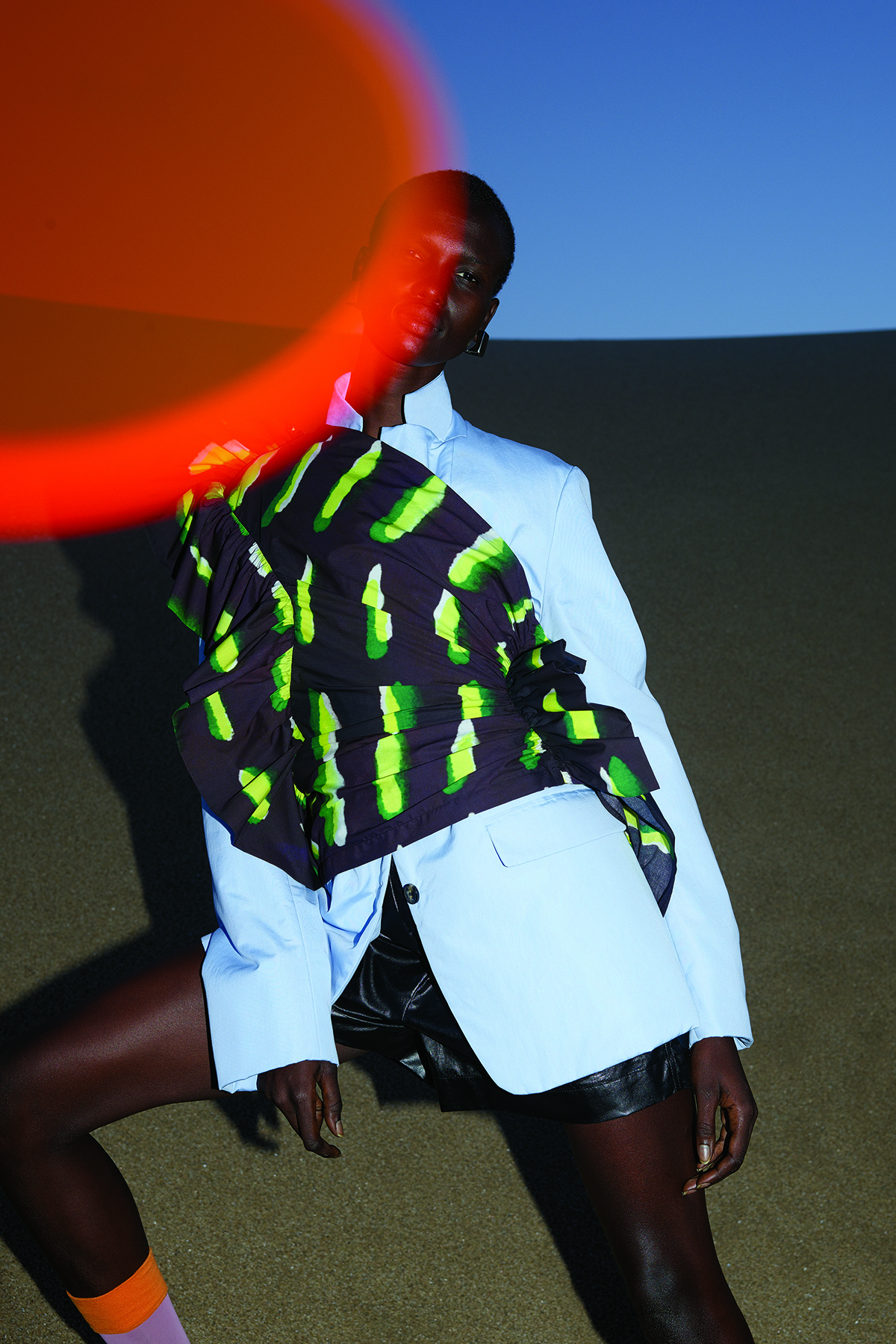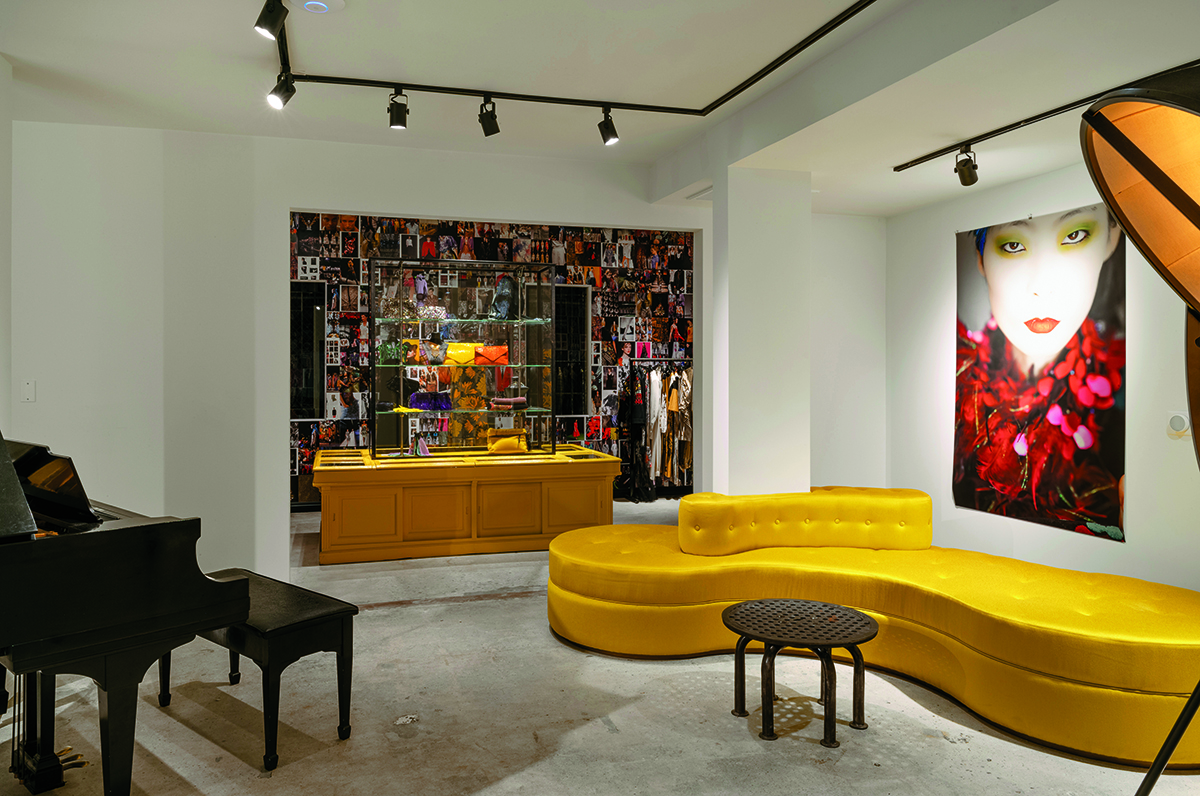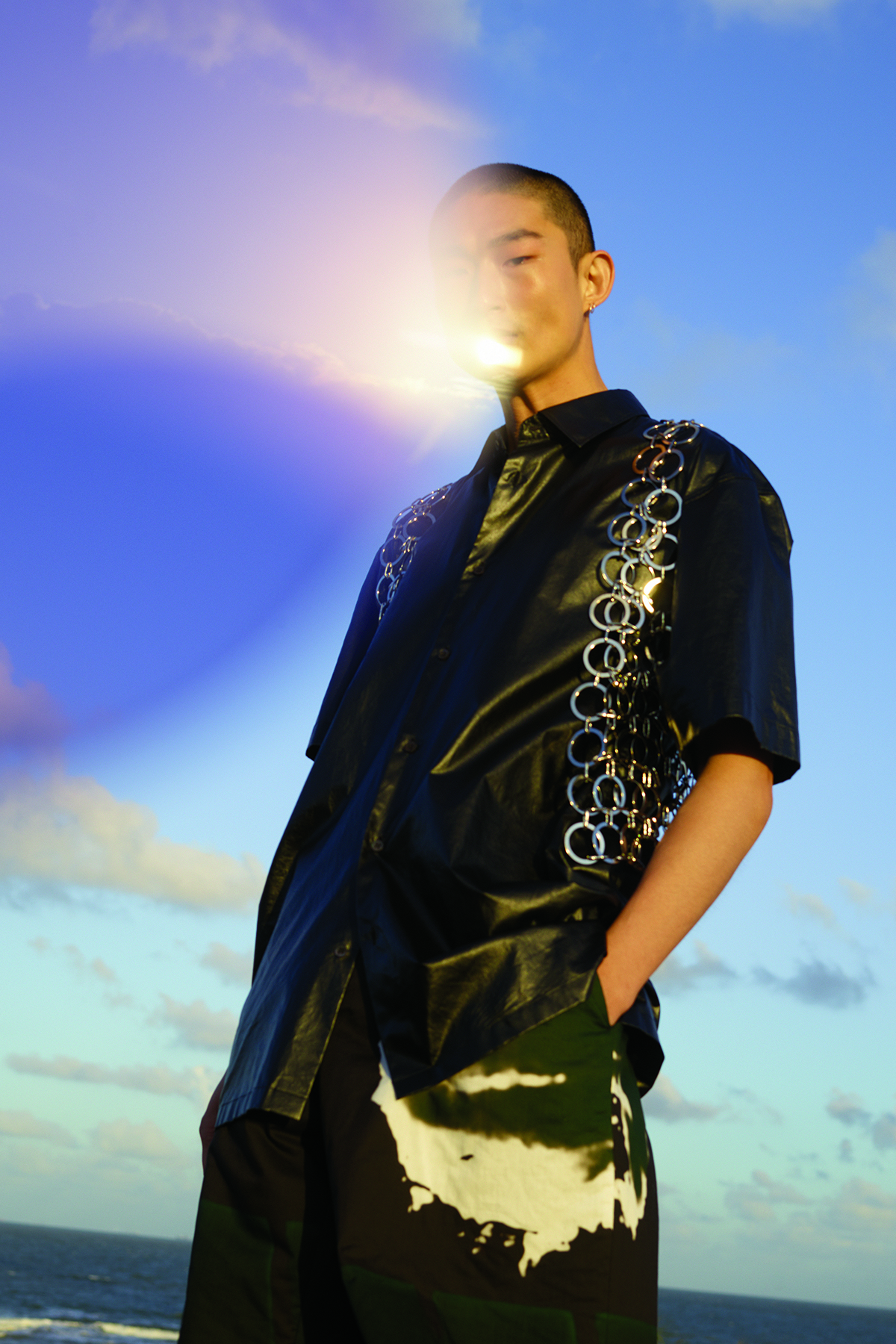Locked down in his native Belgium, designer’s designer Dries Van Noten reflects on the allure of Los Angeles and why he chose the city for his first U.S. store
Words by STEPHANIE RAFANELLI
Photo by Pamela Berkovic.
Dries Van Noten is a man who lives by seasons. The cult Belgian fashion designer, lauded over the last 35 years for his confident command of color, clashing prints and lavish textiles, divides his time between his waterfront office in Antwerp — dreaming up artistic collections in a former museum warehouse — and the 54-acre gardens of his neoclassical mansion in nearby Lier, which flourish with orderly riots of lupines, roses, dahlias and 50 types of hydrangea. At 62, in Wellington boots and a Barbour jacket, his hair as smooth and silvered as birch bark, he tends daily to his blooms — narcissus in February, peonies and rhododendrons in May — efficiently pruning wayward sprigs and dressing the horse-height stone fireplaces and antique tables inside.
“I think about my garden in the same way as I do my fashion,” he says via Zoom. Now dressed conservatively in navy cashmere, he is so cleanly shaved and neatly scissored that he could pass as a gentle banker with immaculate taste; his Flemish accent adds a steadying dose of realism to the wistful romance of Belgian paintings and brocades in his home. “There’s abundance, lots of color, lots of flowers, but I also spend a lot of time working on the bones of the garden, planting trees, thinking about its future. I don’t do just decorative. My clothes are not purely frivolous. I always think about construction, ideas that go to the very bones of fashion, pushing fashion forward.”
The brand’s U.S. flagship on La Cienega, which took over the site previously occupied by Opening Ceremony. Photo by Jim Mangan.
From his mien and his home, it would be easy to mistake Van Noten for a traditionalist rather than a man still driven by his avant-garde beginnings. Given the opulent (yet restrained) maximalism of his work, his legacy of rule breaking and a creative method that is likened to David Bowie’s, he is improbably reserved and unassuming. In the words of Iris Apfel, “He’s not your typical fashion character.” He is “a man of little ego and big ideas,” said The New York Times in 2014.
“There is a freedom in L.A. that you don’t have in New York or London. I love the food, the art scene, the architecture, nature, the climate. It is a very spontaneous city.”
DRIES VAN NOTEN
Of late, in his magical garden, he’s been thinking a lot about the future, especially during last spring’s lockdown. “On the one hand, it was fantastic; we could really enjoy the garden, and we had a new dog to house-train.” (Harry — his and his partner Patrick Vangheluwe’s beloved Airedale terrier — had died the previous September.) “But we had all these worries. We were shipping out the last pieces of our [Spring/Summer 2020 women’s] Christian Lacroix collaboration and they were all blocked in customs and being returned. How were we going to cope with everything closed? How would we make a new collection?” The answer: in easy-to-find cotton and organza, rather than his trademark jacquards — and via Zoom calls. The Spring/Summer 2021 collection emerged as a collaboration with the estate of 1930s New Zealand surrealist artist Len Lye, a friend of Man Ray, who scratched and painted psychedelic images directly onto celluloid film. “We didn’t have the possibility to do all the prints we wanted, so it was little like going back to the beginning, to the essence of fashion.”
Women’s Spring/Summer 2021. Photo by Viviane Sassen.
It was also time for ruminating on the relevance and very nature of the industry itself, an over-delivering dysfunctional behemoth that has lost consumers’ awe and respect. “From before the COVID crisis, people were saying, ‘It’s much too fast, it’s too much, it’s ridiculous, it’s only about logos and profit, people flying all around the world just to see fashion shows. It’s not sustainable, it’s sending out the wrong message. Fashion has become so careless. Why does a certain garment cost 1,000 euros and then one month later, it goes on sale for 500?’” In response, joined by the likes of designers Thom Browne, Erdem and Gabriela Hearst and a consortium of retailers, he wrote an open letter to the fashion industry bidding it embrace the enforced restraint of the lockdown as a permanent positive change. (He reduced the size of his own collection by about 30 to 40 percent.) The forum called for slower, more sustainable fashion, an emphasis on lasting value and the realignment of delivery with the seasons, fixing the disequilibrium that spawned Black Friday discount culture. Van Noten adds, “People need to fall in love with fashion and understand clothes again.”
He also pondered the encroaching death of brick-and-mortar retail, hastened this past year by lockdowns. His counterintuitive conclusion was considered rather high-risk. In the middle of the pandemic, he decided to open an 8,500-square-foot retail space, less a store than a curated multidisciplinary creative salon, in the former Opening Ceremony building in West Hollywood. (That brand announced the closure of all its stores last January around the same time as Barneys New York; both were Dries Van Noten stockists.) “At the beginning, everyone was quite surprised,” he laughs. “But I thought there was a positive message, that we still believe in bricks and mortar. It seemed a good time to experiment.” And a good place. “There’s a very open creative mentality in L.A. Every artist makes music and every musician makes art and acts. L.A. is a very spontaneous city. It’s also a city which allows you trial and error.”
L.A. artist Adam Tullie paints a mural for the new store. Photo by Jim Mangan.
Van Noten’s instincts have rarely failed him. In the fashion world, he is regarded in the same light as Rubens, Brueghel and van Eyck: a Flemish master who paints in color, print, embellished textiles, and whose final masterpiece is his runway show — a beautiful moving painting, often one of the most memorable of Paris Fashion Week. By 2017, he had clocked up 100. At his Spring 2005 runway show, marking the brand’s 50th collection, models paraded along a dining table-turned-catwalk that seated 500 dinner guests. For Spring 2015, models lounged like subjects in a Pre-Raphaelite painting on a mosslike carpet woven by Argentine artist Alexandra Kehayoglou. But for his Len Lye-inspired Spring/Summer 2021 men’s and women’s collection, the showcase took place virtually last fall via a film by Dutch artist Viviane Sassen. “I thought it was going to be terrible not having a runway show,” he says. “But people really loved it.”
“People need to fall in love with fashion and understand clothes again”
dries van noten
Since Van Noten debuted his first menswear collection in 1986, as one of the sensational Antwerp Six (who graduated from the Belgian city’s Royal Academy of Fine Arts, the alma mater of Vincent van Gogh), he has always produced work of strange and surprising beauty underpinned by a cerebral and complex range of influences from art, music and film. In 2014, an exhibition of more than 400 works of art — including items lent by museums and collectors to Paris’s Musée des Arts Décoratifs — dedicated to his inspirations was a testament to his artistic gravitas.
Like an exquisite, artisanal gem in comparison to the showy celebrity chef-helmed restaurant groups represented by certain luxury conglomerates, Van Noten has always trodden an unconventional path with a singular, independent vision, becoming an exemplar of the commercially successful independent designer. And since he controversially sold a majority stake of his company to the Spanish firm Puig in 2018 (parent company of Carolina Herrera, Jean Paul Gaultier and Paco Rabanne), little has changed. He has never had advertising campaigns or courted celebrity (Dries-heads like Cate Blanchett reportedly pay for their coveted cloth). He has never overexposed or overstretched his genius with pre-collections or diffusion ranges. In the cheap age of influencers, Van Noten has preserved an air of mystery about himself and his label, coupled with a deep respect for craft and for fashion as cultural code. “Dries clothes have a transformative effect: the wearer becomes a more interesting, enigmatic, intriguing person,” Simon Doonan, former creative director of the late Barneys New York, told The New York Times in 2008. “If Virginia Woolf or Isadora Duncan were alive today, they would be flying to Antwerp to buy Dries.”
A 1928 Steinway sits at the entrance of the archive room. Photo by Jim Mangan.
Van Noten’s modus operandi and his battle cry — “evolution rather than revolution” — have always been an antidote to the ailments of fashion and its exhaustively recycled tropes. He has spent more than 30 years experimenting with the meaning of beauty. “It has to be difficult-pretty,” he says now. “Beauty with a question mark. I think fashion can’t be too easy for the eye.” The prints for his 2019 womenswear collection were derived from botanicals from his garden: “It was end-of-season flowers with [mildew and bugs] and holes in the leaves.” His Fall 2009 womenswear collection was inspired by his own emotional reaction to the “horrible beauty” of Francis Bacon, translated in shades of shrimp pink and mauve.
Pieces from these collections and others can now be bought and sold at the shoppable archive in the new flagship on La Cienega Boulevard, which soft-launched in October. The artistic laboratory includes an evolving mural painted by local artist-musician Adam Tullie; a vinyl room curated by musicians like L.A.’s Devendra Banhart; The Little House, an art exhibition space in an ivy-covered adjoining bungalow; blooms from botanical artist Azuma Makoto; and of course a tropical garden. (An eatery is coming — Van Noten famously serves food at all his shows, adding a further dimension to his experiential runway collections.)
“There’s a very open, creative mentality in L.A.”
dries van noten
He designed the space remotely last summer, adding vintage furniture and blocks of sunny narcissus yellow. With concrete floors, the midcentury building has a more raw aesthetic than the flea-market Baroque that his friend Gert Voorjans gave his stores in Antwerp and Paris (two of seven stand-alone stores worldwide). “I was working on collections all day, and during the night I was on FaceTime with people in L.A. saying, ‘Show me this corner, show me the ceiling,’ then going shopping for the plants for the garden. ‘Can you stand in front of that palm tree so I can see how tall it is?’” Gardening tools specially commissioned in Japan are also available for purchase, and staff have been trained in textiles.
Van Noten’s respect for his materials has its roots in Antwerp’s historic wool trade, art and garment traditions. His grandfather and father were both tailors, and his father also owned a high-end fashion emporium; both collected paintings, and his mother amassed vintage lace and linens. “I was educated as a Jesuit in a very, very bourgeois family. I had a very [traditional] upbringing.” He was expected to take over the family business, but he was fiercely independent from early on. “The moment I went to the Royal Academy to study fashion, I explained to my father that I was completely uninterested in taking it over. I wanted to make my own collections.” Like the Japanese designers Issey Miyake, Rei Kawakubo and Kenzo Takada, the Antwerp Six (who included Ann Demeulemeester and were preceded by Martin Margiela and followed by Raf Simons) were hailed in Britain in 1986 for their groundbreaking designs, which circumvented the dogmas of Paris and Milan.
Men’s Spring/Summer 2021. Photo by Viviane Sassen.
It is perhaps the outsider spirit of Antwerp that Van Noten recognizes on the Los Angeles fashion scene. “There is something fresh about L.A., a freedom that you don’t have in New York or London.” He’s looking forward to throwing an opening party (if permissible) and meeting all his FaceTime collaborators. “I love the food in L.A., the art scene, the architecture, nature, the climate.” L.A.’s flea markets are also beckoning. He and Patrick are regulars at the “marchés aux puces” in Brussels and Paris, collecting things both beautiful and beautifully ugly. Van Noten has only one complaint: “I think it’s so strange that everybody isn’t cycling in L.A. It’s such an ideal bike city. You could go on longer rides with electric bikes, it would be much more sustainable.”
For now, he has been working on the Fall 2021 collections. “For some reason talking about summer was easier — it’s easier to talk about T-shirts, cotton and jersey over Zoom than a mohair or cashmere sweater. I really miss that you can’t touch everything. And it’s not the same, doing fittings with models in masks; you don’t see their expressions. On female models we do tests with lipsticks. With a mask? Forget it.” But there are some ways in which masterminding collections is more accommodating than his hours in the garden. “In fashion, if you want it to rain for a fashion show, we can organize it inside. But in nature you wait, you can’t control the climate.” He laughs again, his accent still coming off a little stern. “Gardening makes you humble.”
Feature Image: A photograph depicting Serge Lutens’ makeup for the Fall/Winter 2020 women’s collection hangs inside the new L.A. outpost’s “Big House.” Photo by Jeff Forney.
A version of this story originally appeared in the Spring 2021 issue of C Magazine.
Discover more STYLE news.


